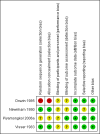Fetal manipulation for facilitating tests of fetal wellbeing
- PMID: 24318544
- PMCID: PMC11500818
- DOI: 10.1002/14651858.CD003396.pub2
Fetal manipulation for facilitating tests of fetal wellbeing
Abstract
Background: Manual fetal manipulation has been suggested to improve the efficiency of antepartum fetal heart rate testing.
Objectives: The objective of this review was to assess the merits or adverse effects of the use of manual fetal manipulation in conjunction with tests of fetal wellbeing.
Search methods: We searched the Cochrane Pregnancy and Childbirth Group's Trials Register (30 September 2013).
Selection criteria: All published and unpublished randomised controlled trials assessing the use of fetal manipulation versus mock stimulation, no stimulation or other types of stimulation, used in conjunction with cardiotocography or other tests of fetal wellbeing.
Data collection and analysis: Three review authors independently assessed studies for inclusion, assessed trial quality and extracted data. Data were checked for accuracy. We contacted authors of published and unpublished trials for further information.
Main results: We included four trials with a total of 1280 women with 2670 episodes of participation. No trial was at low risk of bias for all domains and only two trials were at low risk of bias for both selection and attrition bias.Fetal manual manipulation decreased the incidence of non-reactive antenatal cardiotocography test compared to mock or no stimulation. However, this was not statistically significant (average risk ratio (RR) 0.31, 95% confidence interval (CI) 0.02 to 6.20, I² = 96%; two trials, N = 2350). There was also no significant reduction in the mean testing time to achieve a reactive result (mean difference -2.29 minutes, 95% CI -9.61 minutes to 5.03 minutes, I² = 97%; two trials, N = 560).Comparing fetal manual manipulation with vibroacoustic stimulation, there was no significant difference in the incidence of non-reactive cardiotocography or the need for contraction-stress test.There were no data available on other outcomes such as perinatal mortality, fetal distress, maternal anxiety and gestation at delivery.
Authors' conclusions: There is insufficient evidence to support the use of manual fetal manipulation during cardiotocography or other tests of fetal wellbeing. More studies of manual fetal manipulation that utilises standardised protocol should be encouraged.
Conflict of interest statement
None known.
Figures






Update of
-
Fetal manipulation for facilitating tests of fetal wellbeing.Cochrane Database Syst Rev. 2001;(4):CD003396. doi: 10.1002/14651858.CD003396. Cochrane Database Syst Rev. 2001. Update in: Cochrane Database Syst Rev. 2013 Dec 07;(12):CD003396. doi: 10.1002/14651858.CD003396.pub2. PMID: 11687201 Updated.
References
References to studies included in this review
Druzin 1985 {published data only}
-
- Druzin ML, Gratacos J, Paul RH, McCart D, Smith M. Antepartum fetal heart rate testing. XII. The effect of manual manipulation of the fetus on the nonstress test. American Journal of Obstetrics and Gynecology 1985;151:61‐4. - PubMed
Newnham 1990 {published data only}
-
- Newnham JP, Burns SE, Roberman BD. Effect of vibratory acoustic stimulation on the duration of fetal heart rate monitoring tests. American Journal of Perinatology 1990;7:232. - PubMed
Piyamongkol 2006a {published data only}
-
- Piyamongkol W, Trungtawatchai S, Chanprapaph P, Tongsong T. Comparison of the manual stimulation test and the nonstress test: a randomized controlled trial. Journal of the Medical Association of Thailand 2006;89(12):1999‐2002. - PubMed
-
- Trungtawatchai S, Chanpraparp P. Comparison of the nonstress test (NST) and NST with manual stimulation test (MST). Thai Journal of Obstetrics and Gynaecology 1999;11(4):273.
Visser 1983 {published data only}
-
- Visser GHA, Zeelenberg HJ, Vries JIP, Dawes GS. External physical stimulation of the human fetus during episodes of low heart rate variation. American Journal of Obstetrics and Gynecology 1983;145:579‐84. - PubMed
Additional references
Higgins 2011
-
- Higgins JPT, Green S, editors. Cochrane Handbook for Systematic Reviews of Interventions Version 5.1.0 [updated March 2011]. The Cochrane Collaboration, 2011. Available from www.cochrane‐handbook.org.
Keegan 1980
-
- Keegan KA Jr, Paul RH. Antepartum fetal heart rate testing. IV. The nonstress test as a primary approach. American Journal of Obstetrics and Gynecology 1980;136(1):75‐8. - PubMed
Piyamongkol 2006b
-
- Piyamongkol W, Trungtawatchai S, Chanprapaph P, Tongsong T. Comparison of the manual stimulation test and the nonstress test: a randomized controlled trial. Journal of the Medical Association of Thailand 2006;89(12):1999‐2002. - PubMed
RevMan 2012 [Computer program]
-
- The Nordic Cochrane Centre, The Cochrane Collaboration. Review Manager (RevMan). Version 5.2. Copenhagen: The Nordic Cochrane Centre, The Cochrane Collaboration, 2012.
Trungtawatchai 1999
-
- Trungtawatchai S, Chanpraparp P. Comparison of the nonstress test (NST) and NST with manual stimulation test (MST). Thai Journal of Obstetrics and Gynaecology 1999;11(4):273.
Publication types
MeSH terms
LinkOut - more resources
Full Text Sources
Other Literature Sources

